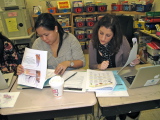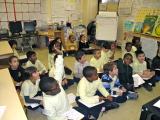-
Category 2
Selected in 2012
-
Grades: pre k - 5
School Setting: urban
Town Population: 477,377
Student Enrollment: 829
Student Demographics:
Black/African American: 18%
Teacher/Student Ratio: 1:16
White/Caucasian: 27%
Hispanic: 39%
Hawaiian/Pacific Islander: 0%
Asian: 15%
Native American: 0%
Other: 1%
% Reduced Lunch: 76%
% ELL Learners: 15.8%
Founded: 1880 -
PRINCIPAL:
Paul Martuccio -
CONTACT:
191 Vermont Avenue
Staten Island, NY 10305
718-447-1462
pmartuc2@schools.nyc.gov
P. S. 13 - M. L. Lindemeyer School
Staten Island, NY
The organization and utilization of the school-wide Positive Discipline Initiative has become a strong foundation in building students’ social and life skills. Currently in our third year, every class holds meetings each morning for 18 minutes. During these sessions, the students practice compliments and appreciation, discuss day to day issues, learn how to solve problems through discussion, develop communication skills, and practice role playing. These morning sessions “set the tone” for the remainder of the school day.
- Describe specific programs in place to ensure that families are involved in the success of your school and students.
-
Decades of research show that when parents are involved in their child’s education, students have higher grades and test scores, better school attendance, increased motivation, and lower suspension rates. The past few years, we have successfully built a school community where parents feel welcome and respected and, in turn, have had an increase in the number of parents in attendance at highly participated events. Some of these programs are:
Writers Celebration – held 3 times per year, parents are invited during school to celebrate their child’s accomplishments in Writing. Students regale their parents by reading their essays and compositions.
Family Fun Nights – each month, PS 13 hosts a themed event to which all families are invited to attend. Each Family Fun Night is planned and implemented by the School Leadership Team. We have hosted events, such as, International Dance Night, Fitness Night, and International Taste-Testing Night.
Adult ESL Classes – We have partnered with a community based organization which offers English as a Second Language evening classes twice a week, free of charge. In doing so, we hope to promote and encourage more access to the learning community by bridging the language barrier.
Common Core Workshops – facilitated by our in-house coach, parents are introduced to the Common Core Learning Standards and are apprised of the expectations and goals of each standard.
Ongoing Communication – monthly newsletters are crafted by each grade. Through the newsletter, unit goals and objectives in Reading, Writing, and Math are communicated. Parents are informed of what is being taught. We also require all our students to write monthly letters to their parents. These letters detail each child’s particular goals within particular units of study. Parents can then “drill down” in terms of what their child needs to accomplish during instruction. - Describe your philosophy of school change or improvement.
-
Results Now, by Mike Schmoker, has impacted, informed, and justified the way I lead in several ways. Within Results Now, Chapter 8 begins with a short anecdote which signifies, to me, what leadership should be. In this account, Schmoker talks about a school team that attended a “much hyped but time wasting workshop” only to learn during their ride home that all of the answers they needed in terms of instruction could be based on what they already collectively knew. As a result, the Principal, after seeing significant growth and results, “wondered aloud why they hadn’t always done business that way.”
Professional Learning Communities are the strength within the Public School 13 community. Teachers understand that the onus of student achievement falls squarely on our shoulders and that professional development, in terms of auditorium-style “sit down and learn” approaches, are few and far between. Instead, an “on the job training” approach is employed where grade teams and I meet twice per week. With these meetings come autonomy, planning, analysis, and an expertise derived from the power of collaboration. As a result of our findings, we can make informed decision in terms of supplies, approaches, interventions, and other needs our students present.
In implementing this collaborative approach, I was not only able to engage teachers in the conversation, but was also able to identify willing and able leaders that help drive our school toward even greater academic excellence. In distributing the leadership I am pleased to report that we are not only building capacity within our learning community but also within the district as multiple teachers here have decided to pursue degrees and subsequent licenses in School Building Leadership.
As the leader of this learning community, I have come to understand that leadership itself is not what a leader can accomplish on his or her own, but what they can facilitate in terms of the systems employed within the building. While I am convinced that strong, focused leaders are at the beginning of every successful school, I also appreciate that the power of the waterfall is nothing but a bunch of drips working together.
All things considered, I would be remiss if I didn’t include the fact that we have seen a steady, significant improvement in terms of academic gains at our school. My staff and I are confident that the most important factors of this success are: the team approach, the frequency of the meetings themselves, and the incorporation of the inner workings of Schmoker’s Results Now into our greater school vision. - What is the single most important factor in the success of your school that others could replicate?
- I would like to elaborate on PS 13’s “Teacher Meeting Time”. In addition to the regular preparation periods, teachers have been afforded an additional preparation period each week. These additional weekly periods have been scheduled, budgeted for, and outlined with a focus on professional development and Common Core Standards consideration. Teachers also meet for an additional 37 ½ minutes during NY City’s mandated Extended Day. The intended outcome of these meetings is to focus on the implementation of the Common Core Standards. During these two sessions each week, the staff develops proprietary Literacy and Math lessons aligned to the Common Core Learning Standards. All Common Core Literacy lessons are interdisciplinary and triangulated to include, but not limited to, reading and writing standards taught and learned via Social Studies content. Each lesson in the core curriculum areas incorporates differentiated tasks based on each student’s capability. The expectation is for students to garner a greater comprehension of skills and strategies being taught. Please note that our students’ education is in no way compromised with the additional preparation period as the children receive instruction in Social Studies through the Arts during that time.
- Describe the program or initiative that has had the greatest positive effect on student achievement.
- The organization and utilization of the school-wide Positive Discipline Initiative has become a strong foundation in building students’ social and life skills. Currently in our third year, every class holds meetings each morning for 18 minutes. During these sessions, the students practice compliments and appreciation, discuss day to day issues, learn how to solve problems through discussion, develop communication skills, and practice role playing. These morning sessions “set the tone” for the remainder of the school day. The objective of the initiative is to create an environment that invites and expects social responsibility and academic excellence.
- Describe how data is used to improve student achievement and inform decision making.
-
Data plays an integral role in improving student achievement and informing decision making.
We have developed our Extended Day program into a differentiated learning experience based on the data compiled through the state’s yearly assessments. All students in grades 3 through 5, as well as students identified as at-risk in Grades 1 and 2, are mandated to attend. Classes are organized by reading levels and are reorganized after each Independent Reading Level Assessment.
The Math and Literacy skills and strategies reinforced during our After-School and Saturday Academies for Grades 3 through 5 are also determined by the data collected through state assessments, city diagnostic exams, and teacher evaluations.
Monthly grade meetings are data driven. Grade leaders and administrators convene to discuss assessment data and the implications. These meetings result in making changes not only within the grade, but systemically throughout the school.
Lastly, we have taken on an active attendance initiative. Based on attendance data, parents are informed of excessive absences via monthly written correspondence. As one of our objectives is to recognize student initiative, students are afforded the opportunity to be recognized twice each month: for 100% attendance for the month and/or maintaining an up-to-date attendance record of 95% or higher.
Stats
-
Category 2
Selected in 2012
-
Grades: pre k - 5
School Setting: urban
Town Population: 477,377
Student Enrollment: 829
Student Demographics:
Black/African American: 18%
Teacher/Student Ratio: 1:16
White/Caucasian: 27%
Hispanic: 39%
Hawaiian/Pacific Islander: 0%
Asian: 15%
Native American: 0%
Other: 1%
% Reduced Lunch: 76%
% ELL Learners: 15.8%
Founded: 1880 -
PRINCIPAL:
Paul Martuccio -
CONTACT:
191 Vermont Avenue
Staten Island, NY 10305
718-447-1462
pmartuc2@schools.nyc.gov









